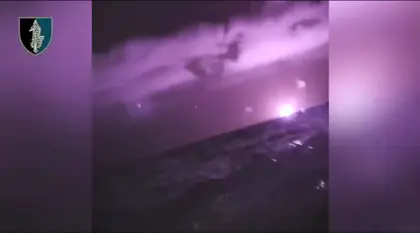Ukrainian special forces revealed on-the-scene footage of its flash-of-lightning special operation “Citadel” during which they blew up a mining platform illegally captured by the Russians in the Black Sea.
The Ukrainian Special Operations Forces (SSO) of the Armed Forces reported via Telegram details of the operation with up-close, in-person video.
JOIN US ON TELEGRAM
Follow our coverage of the war on the @Kyivpost_official.
“Operators of the 73rd Maritime Center of the SSO conducted an extremely complex and effective operation in the Black Sea near the coast of the temporarily occupied Crimea,” the caption to the published video read.
How Did the Russians Use the Platform?
According to intelligence, one of the illegally seized drilling platforms was used by Russia to enhance the operation of the Iranian-made Mohajer-6 unmanned aerial vehicle.
“They installed equipment that increases the range and radius of its operation,” the SSO reported.
The Mohajer-6 is designed for reconnaissance and attack, can carry four guided missiles, and has a range of up to 200 kilometers over 12 hours.
This drone was used by the Russians for reconnaissance and subsequent strikes by Shahed kamikaze drones on critical infrastructure facilities in the south of Ukraine.
The Russians also installed the Neva-B surface object detection radar station on the platform.
The Neva-B radar station has compact dimensions and serves as a tracking radar both on land and at sea. The radar was developed by the Rosoboronexport corporation for the possibility of tracking objects in large open steppe or open water areas.

‘Smoke Screens Protect Troops’ as Ukrainian Tanks Strike Russian Forces and Evade FPV Drones in Kurakhove
The radar can simultaneously track up to 200 targets and operates in the Ka-band, enabling detection of even the smallest targets. The developers claim that their radar is designed to protect critical infrastructure: bridges, dams, etc.
Neva-B can detect a person at up to 2 km, a car (or boat) at 15 km, and a truck (or a large boat) at a distance of up to 30 km.
“With the help of this radar, the Russians controlled the situation in the northwestern part of the Black Sea,” the SSO wrote.
Details of the Special Operation
“After careful planning and preparation, the group of the 73rd SSO Maritime Center began the task of destroying enemy facilities,” the message read.
The operation was carried out in the zone of constant patrol by the Russian Air Force and Navy.
At night, the boats of the 73rd Marine Center approached the mining platform. After carrying out special actions and cleaning, the fighters replaced the objects.
Subsequently, the combat group withdrew to a safe distance and detonated the platform.
“As a result, the enemy’s important equipment was captured, and the mast with the antenna was blown up,” the report said.
A training unit with the mission of producing combat divers and soldiers, like the US Navy SEALS, Ukraine’s 73rd Naval Center of Special Operations is a highly secretive unit, perhaps inevitably because of its commando reputation, become a favorite subject of Ukrainian military media.
They are widely reported to have trained for years, before the war, with NATO special operations units from the US, Poland, and Lithuania among others.
Why This Is Important
As the SSO notes, the special operation ensured the safer movement of ships and limited Russia’s capabilities in the northwestern part of the Black Sea.
Additionally, the fighters managed to capture a rather rare and valuable Russian radar station.
The AFU conducted a similar successful operation last year when it recovered control of the Boyka oil platforms Russian forces had illegally occupied and used as open water radar platforms.
As reported by the Kyiv Post at the time:
Ukraine’s Armed Forces (AFU) have regained control of the Boyko Towers gas and oil production platforms located near the shores of Crimea in the Black Sea, which had been occupied by Russia since 2014.
“Since the beginning of the full-scale invasion, Russia has been using them for military purposes, including as helipads and for radar equipment placement,” reported the Main Intelligence Directorate of the Ministry of Defense (HUR) via Telegram on Monday, Sept. 11, 2023.
You can also highlight the text and press Ctrl + Enter






